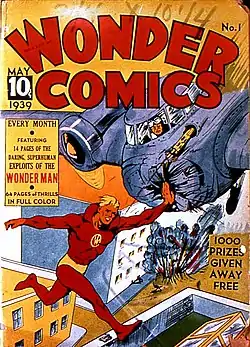Wonder Man (Fox Publications)
Wonder Man is a fictional superhero created by American cartoonist Will Eisner, whose only appearance was in the comic book Wonder Comics #1 (May 1939). The character is of some historical significance due to a lawsuit that resulted from his only appearance.
| Wonder Man | |
|---|---|
 Wonder Man's only appearance was in Wonder Comics #1 | |
| Publication information | |
| Publisher | Fox Publications |
| First appearance | Wonder Comics #1 (May 1939) |
| Created by | Will Eisner |
| In-story information | |
| Alter ego | Fred Carson |
| Abilities | Super-strength · Super-speed · Super-stamina · Extra-sensory powers · Invulnerability · Flight · Longevity |
Fictional character history
Wonder Man's secret identity is Fred Carson, radio engineer for the International Broadcasting Corporation. During an excursion to Tibet, an old monk bestows Carson with a ring that gave him the power to fight evil when the need arose.[1] His powers are almost exactly like those of Superman.[2] He travels to war-torn Tatonia, beats up the invading dictator General Attila, and stops the war. Then he rescues his boss' daughter, Red Cross nurse Brenda, and kisses her.[3]
Publication history
Wonder Man was created by Will Eisner in the Eisner-Iger Shop for Victor Fox, who was publishing astrology magazines when he ran across his distributor's reports on the incredible sales for National Periodicals' Action Comics in February 1939. He immediately decided to get into the comic book business, setting up offices in the same building DC had theirs, then contacted Eisner. Using the pen name Willis, Eisner wrote and drew the first issue of Wonder Comics which appeared on the news stands less than six weeks later.
Lawsuit
On March 15, 1939, DC Comics brought a copyright infringement lawsuit against Fox, due to the character's similarities to Superman, as well as story and illustration elements that were similar to previous Superman adventures.[4] The case was brought to court in Detective Comics, Inc. v. Bruns Publications, Inc., 111 F.2d 432 (2d Cir. 1940), in which Eisner defended the originality of his creation. Despite this testimony, the subsequent decision forced Fox to drop the character after just one issue.[5]
Wonder Comics however, continued as a title, featuring Yarko the Great in #2, then changed its name to Wonderworld Comics featuring The Flame in #3 and continued for another 30 issues.[6]
This was the first copyright lawsuit in comic book history and set a precedent for DC Comics' vigorous protection of its characters (see also National Comics Publications v. Fawcett Publications).
The dispute is depicted in disguised fashion in Eisner's semi-autobiographical graphic novel, The Dreamer. However, this depiction is at odds with Eisner's own testimony at the trial, transcripts of which were unearthed in 2010.[7]
See also
- Master Man, a similar character.
References
- Nevins, Jess (2013). Encyclopedia of Golden Age Superheroes. High Rock Press. p. 296. ISBN 978-1-61318-023-5.
- Markstein, Don. "Wonder Man". Don Markstein's Toonopedia. Retrieved 2 April 2020.
- Mougin, Lou (2020). Secondary Superheroes of Golden Age Comics. McFarland & Co. pp. 23–24. ISBN 9781476638607.
- Mitchell, Kurt; Thomas, Roy (2019). American Comic Book Chronicles: 1940-1944. TwoMorrows Publishing. p. 30. ISBN 978-1605490892.
- Mougin, Lou (2020). Secondary Superheroes of Golden Age Comics. McFarland & Co. pp. 23–25. ISBN 9781476638607.
- Benton, Mike (1992). Superhero Comics of the Golden Age: The Illustrated History. Dallas: Taylor Publishing Company. pp. 191–192. ISBN 0-87833-808-X. Retrieved 8 April 2020.
- http://thecomicsdetective.blogspot.com/2010/07/dc-vs-victor-fox-testimony-of-will.html
External links
- Wonder Man at Toonopedia.
- Wonder Comics #1 - A Wonderful Prize? on Wonder Man ring prize from Wonder Comics #1.
- Article by Mikel Midnight from material by Ron Goulart.
- Court transcripts and analysis of testimony in the case of Detective Comics, Inc. v. Bruns Publications, Inc. from The Comics Detective.
- Transcript of Eisner's testimony at trial